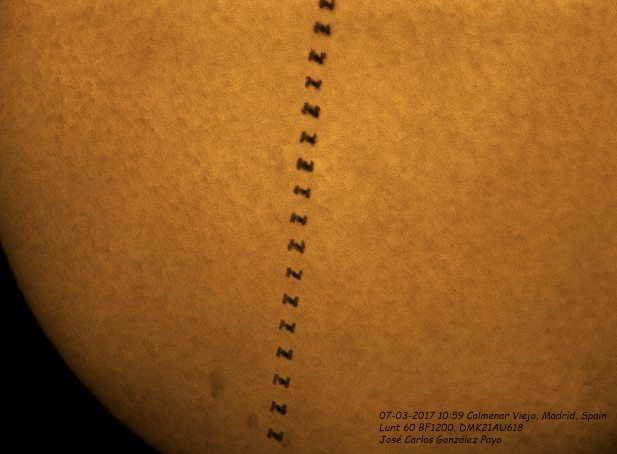The ISS, a modular structure with its large solar panels extended, appears as a sharp silhouette against the Sun’s blazing backdrop. The Sun, resembling a colossal orange sphere, radiates a warm glow, diffused by a solar filter on the camera that protects the sensor from the intense light and allows for the details of the solar surface and the station’s outline to be visible. The filter might give the Sun a textured appearance, highlighting sunspots or solar flares, while the ISS could be seen in transit, captured at the perfect moment as it crosses the solar face. The surrounding space is steep black, serving as a stark contrast to the bright hues of the Sun, emphasizing the vastness of the cosmos and the remarkable human endeavor that is the ISS.
Capturing an image of the International Space Station (ISS) transiting the Sun requires precise timing, specialized equipment, and a good understanding of photography, especially of solar subjects. Here’s how such an image could be achieved and what makes it particularly intriguing:
Materials:
- Camera with a High Frame Rate: To capture the split-second transit of the ISS, a camera capable of taking multiple frames per second is essential.
- Long Lens: A telephoto lens or even a telescope with a camera adapter is required to get a detailed, close-up view of the Sun and the ISS.
- Solar Filter: To safely photograph the Sun and protect the camera sensor, a high-quality solar filter is used. This filter allows only a fraction of the Sun’s light to pass through, revealing solar features without overwhelming the image.
- Tracking Mount: A motorized tracking mount can be helpful to follow the Sun’s movement across the sky, keeping it centered in the frame.
- Software for Planning: Applications or software that can predict ISS transits over the Sun at your location are crucial for timing the photograph correctly.
Techniques:
- Timing and Planning: The photographer must calculate the exact time and location for the ISS transit. This often involves using astronomical prediction software.
- Exposure Settings: Setting the correct exposure is a delicate balance to capture the ISS’s silhouette without underexposing the Sun’s details or overexposing the image.
- Focus: Achieving sharp focus is critical. Many photographers use live-view mode on their cameras and zoom in digitally to fine-tune the focus on the edge of the Sun.
- Bracketing: Taking multiple shots at different exposures can ensure that at least one image has the ideal exposure for both the ISS and the solar features.
Curiosities of the Image:
The image itself is a marvel of both astronomy and photography. It represents a moment where human-made technology intersects with the grandeur of our solar system’s central star. The ISS orbits the Earth at approximately 28,000 kilometers per hour (17,500 miles per hour), and the precise capture of this rapid transit—often lasting less than a second—speaks to the photographer’s skill.
Additionally, the image is not just a snapshot of two objects in space; it’s a fusion of scales and distances that are hard to comprehend. The ISS, though massive by human standards, appears tiny against the vastness of the Sun, which is about 109 times the diameter of Earth.
The use of a solar filter adds another layer of intrigue. It allows the viewer to see surface details of the Sun, such as sunspots or solar prominences, which are usually invisible to the naked eye due to the Sun’s brightness. It also casts the Sun in a different light, often highlighting the active and dynamic surface of our star, which is not perceivable in the general daylight.
In essence, such a photo is not just a praise to the photographer’s prowess but also a powerful reminder of humanity’s place in the cosmos—capable of remarkable technological feats, yet dwarfed by the celestial bodies that surround us and keep being still a mistery to humankind.
